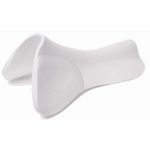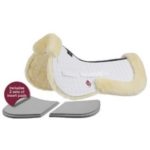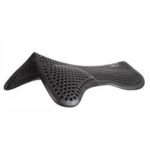
Saddle Pads and Pad Accessories
By Jochen Schleese, CMS, CSFT, CSE
©2020 Saddlefit 4 Life° All Rights Reserved
Saddle fitting is a multifactorial and highly dynamic part of our equestrian industry, and one that is often poorly practiced and performed by non-qualified and improperly trained fitters. In a recent Research Refresh on the Equine platform we saw that saddles fitted more than once annually correlated to horses that had more asymmetrical back musculature, and riders that were more balanced and had reduced back pain.
One of the questions I will often be faced with as a non-saddle fitter, is whether or not we can use a saddle pad to improve the fit of a saddle. So let’s explore this question a little bit, with some advice from Certified Master Saddler and Saddle Ergonomist Jochen Schleese from Saddlefit 4 Life.
The purpose of a saddle pad
The simple purpose of a saddle pad is to protect the leather of the saddle from the sweat and hair of the horse. But of course, in true human style, we have made things more complicated than they need to be.
In a saddle that fits well, the saddle pad only needs to fulfil the above function, and in that case a thin cotton saddle pad shaped to the contours of the horse’s back is perfect, and all that is needed.
When we require our saddle pads to meet additional needs or goals, we might be asking for them to
- Distribute pressure more evenly from the saddle and rider
- Reduce friction between the horse and saddle
- Absorb shock
- Improve the balance of a saddle
These are all goals that should, and can, be met by a well-fitting saddle.
But, as always, the clients will use what they choose to use, and many non-qualified saddle sales persons will sell a saddle to a rider that bridges, pinches the shoulder, isn’t balanced, or that the horse can ‘grow into.’ And in some situations, riders will have many horses and only a limited amount of saddles, using one saddle for various horses and improving the fit with a riser pad, a sheepskin with fillers, gel pads, and various other variations.
Let’s look at some of these.
- Riser pads can be used to lift the saddle in the front, or in the back, as long as the pad material gradually thins towards the front end or the back end. If this is not adhered to, these pads will twist or break the saddle tree. These come in many materials and levels of adjust-ability, including foam, felt, rubber, and material designs.
- Filler/shim pads are sheepskin or similar pads with usually four, and sometimes 6
 pockets that allow you to place an insert or shim into the pockets to raise the saddle in specific areas, adjusting the balance of the saddle from front to back or side to side. This can be used to compensate for the horse that is asymmetrical or is growing and developing, as well as for an interim solution until the saddle fitter comes out to fit the saddle correctly. They don’t work at all unless the saddle pad is actually attached (with Velcro) to the saddle. Otherwise the shim/filler pad will always move around between the horse’s back and the saddle, causing huge problems – same as an orthotic will move around in a shoe, causing issues when humans walk and land on the edges of the orthotic.
pockets that allow you to place an insert or shim into the pockets to raise the saddle in specific areas, adjusting the balance of the saddle from front to back or side to side. This can be used to compensate for the horse that is asymmetrical or is growing and developing, as well as for an interim solution until the saddle fitter comes out to fit the saddle correctly. They don’t work at all unless the saddle pad is actually attached (with Velcro) to the saddle. Otherwise the shim/filler pad will always move around between the horse’s back and the saddle, causing huge problems – same as an orthotic will move around in a shoe, causing issues when humans walk and land on the edges of the orthotic. - Gel pads are used to improve shock absorption and to allow a more comfortable fit, and again come in quite a
 few variations. They were originally developed to protect chronic care patients from bed sores. These only work if the gel pad is separated on the left and right side and not more than 3-4” wide and 16-17” long. If it is in one solid piece it will massively increase the heat on the horse’s back and pulls tight on the horse’s spine and wither area (like an elastic band around your finger).
few variations. They were originally developed to protect chronic care patients from bed sores. These only work if the gel pad is separated on the left and right side and not more than 3-4” wide and 16-17” long. If it is in one solid piece it will massively increase the heat on the horse’s back and pulls tight on the horse’s spine and wither area (like an elastic band around your finger).
- Memory foam saddle pads can be used to improve the pressure distribution under a saddle, as the foam will be thinner under areas where the saddle makes closer contact with the back, and thicker under areas where it is further away, improving comfort for the horse and distributing the rider’s weight more evenly across the saddle support area. Memory foam pads increase pressure massively on the horse’s spine and nerves if there is not minimum 4” space for the vertebrae front to back. (Preferably 6-8” in the front and 3-4” in the back to accommodate the spine and wither cap).
- There are three theories concerning the use of thermoplastic saddle pads. They are created to mould the contact surface between the saddle and the horse according to each individual horse-rider-saddle team (like orthotics for shoes), but can be remoulded as the horse develops and changes.
- The mould is made while the horse is standing still and if it hardens to the horse’s back before movement, it will remain smooth and even – but won’t work dynamically because a horse’s three-dimensional back changes during riding.
- The plastic is pre-heated prior to the ride and will then harden during riding. The advantage is that the average back shape from the various gaits will determine the shape of the pad, however, the average pressure point will also harden into the pad and therefore constantly presses into the horse’s back.
- The pad is not pre-heated and placed between saddle and horse’s back and softens up during riding. It hardens only after the ride. The problem here is that during riding it actually has no benefit to either horse or rider, since it only hardens into its shape after the fact. (That would be like a pair of mushy orthotics that do nothing while you’re walking and only harden when you take them out of your shoes).
In effect, the use of thermoplastic pads (orthotic pads) is basically counter-intuitive. They don’t work. Orthotics in shoes work for humans to support the foot and the surface they’re used on (the street) is flat and doesn’t change. The purpose is to protect the foot/leg/back. The underside of the thermoplastic pad (orthotic) is on the horse’s back – which changes constantly during riding. If you want to protect the back, this isn’t it. There are better options.
How to choose
The most important points to consider when choosing a saddle pad, is to ensure that it is correctly shaped to prevent any pressure on the spine, doesn’t further narrow the gullet of the saddle and restrict space and motion, doesn’t decrease the tree width which will restrict the shoulder by increasing the pressure in that area, and fits your horse, saddle rider team. But again – more important is to ensure that your saddle fits properly so that all is really needed is a thin, wither-relief cotton pad to keep the sweat off of the leather.
Any corrective saddle pad should in essence be used only if absolutely necessary to avoid potential damage to the horse’s
back, spine, and wither cap.






